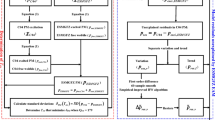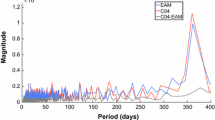Abstract
Polar motion predictions for up to 10 days into the future are obtained from predicted states of the atmosphere, ocean and continental hydrosphere in a hind-cast experiment covering 2003–2008. High-frequency mass variations within the geophysical fluids are the main cause of wide-band stochastic signals not considered in the presently used statistical prediction approach of IERS bulletin A for polar motion. Taking EAM functions based on forecasted model states, derived from ECMWF medium-range forecasts and corresponding LSDM and OMCT simulations, into account the prediction errors are reduced by 26%. The effective forecast length of the model combination is found to be 7 days, primarily limited by the accuracy of the forecasted atmospheric wind fields. Highest improvements are found for forecast days 4–5 with prediction skill scores of the polar motion excitation functions improved by a factor up to 5. Whereas bulletin A forecasts can explain the observed variance within the first 10 days only by up to 40%, half of the model forecasts reach relative explained variances between 40 and 80%.
Similar content being viewed by others
References
Barnes RTH, Hide A, White A, Wilson CA (1983) Atmospheric angular-momentum fluctuations, length-of-day changes and polar motion. Proc R Soc Lond Ser A Math Phys Eng Sci 387(1792): 31–73
Bizouard C, Gambis D (2008) The combined solution C04 for Earth orientation parameters, recent improvements. In: Drewes H (eds) Series on International Association of Geodesy Symposia, vol 134. Springer, New York, p 330
Bizouard C, Seoane L (2009) Atmospheric and oceanic forcing of rapid polar motion. J Geod. doi:10.1007/s00190-009-0341-2
Brzezinski A (1992) Polar motion excitation by variations of the effective angular momentum function: considerations concerning deconvolution problem. Manuscr Geod 17: 3–20
Chen JL, Wilson CR (2005) Hydrological excitations of polar motion, 1993–2002. Geophys J Int 160: 833–839
Dick WR, Richter B (2003) Rapid Service/Prediction Centre, IERS Annual Report 2002. International Earth Rotation and Reference Systems Service, Central Bureau. Verlag des Bundesamts für Kartographie und Geodäsie, Frankfurt am Main, pp 46–53. ISBN 3-89888-875-4
Dick WR, Richter B (2009) Earth Orientation Centre, IERS Annual Report 2007. International Earth Rotation and Reference Systems Service, Central Bureau. Verlag des Bundesamts für Kartographie und Geodäsie, Frankfurt am Main, pp 61–67. ISBN 978-3-89888-917-9
Dill R (2008) Hydological model LSDM for operational Earth rotation and gravity field variations. Scientific Technical Report, STR08/09, GFZ Potsdam, Germany, p 35
Dobslaw H, Thomas M (2007) Simulation and observation of global ocean mass anomalies. J Geophys Res 112: C05040
Drijfhout S, Heinze C, Latif M, Maier-Reimer E (1996) Mean circulation and internal variability in an ocean primitive equation model. J Phys Oceanogr 26: 559–580
Freedman AP, Steppe JA, Dickey JA, Eubanks TM, Sung LY (1994) The short-term prediction of universal time and length of day using atmospheric angular momentum. J Geophys Res 99(B4): 6981–6996
Gendt G, Fang P, Zumberge JF (2000) Moving IGS products towards real-time. In: Proceedings of the 1999 IGS analysis Central Workshop. IGS Central Bureau, Pasadena, California, pp 391–403
Gross RM, Fukumori I, Menemenlis D (2003) Atmospheric and oceanic excitation of the Earth’s wobbles during 1980-2000. J Geophys Res 108(B8): 2370
Hagemann S (1998) Entwicklung einer Parametrisierung des lateralen Abflusses für Landflächen auf der globalen Skala. Examensarbeit, 52, Max-Planck-Institut für Meteorologie, Hamburg, Germany
Johnson TJ, Luzum BJ, Ray JR (2005) Improved near-term UT1R predictions using forecasts of atmospheric angular momentum. J. Geodyn 39: 209–221
Kosek W, Kalarus M, Niedzielski T (2008) Forecasting of the Earth orientation parameters—comparison of different algorithms. In: Capitaine N (ed) Observatoire de Paris UMR8630/CNRS, Paris, France. Proceedings of the Journes 2007: the celestial reference frame for the future, pp 155–158
Luzum BJ, Ray JR, Carter MS, Josties FJ (2001) Recent improvements to IERS Bulletin A combination and prediction. GPS Solut 4(3): 34–40
Thomas M (2002) Ocean induced variations of Earth’s rotation—results from a simultaneous model of global circulation and tides,. Ph.D. dissertation, University of Hamburg, Germany, p 129
von Storch H, Zwiers FW (1999) Statistical analysis in climate research. Cambridge University Press, Cambridge, p 484
Wilson CR, Vicente RO (1990) Maximum likelihood estimates of polar motion parameters. In: McCathy DD, Carter WE (eds) Variation in earth rotation. In: Geophysical monograph series, vol 59. AGU, Washington, DC, pp 151–155
Wolff JO, Maier-Reimer E, Legutke S (1996) The Hamburg Ocean primitive equation model HOPE. Technical Report, vol 13. DKRZ, Hamburg, p 103
Wooden W (2008) Activities of the IERS working group on prediction. In: Capitaine N (ed) Proceedings of the Journes 2007. The celestial reference frame for the future. Observatoire de Paris UMR8630/CNRS, Paris, France, pp 145–150
Author information
Authors and Affiliations
Corresponding author
Rights and permissions
About this article
Cite this article
Dill, R., Dobslaw, H. Short-term polar motion forecasts from earth system modeling data. J Geod 84, 529–536 (2010). https://doi.org/10.1007/s00190-010-0391-5
Received:
Accepted:
Published:
Issue Date:
DOI: https://doi.org/10.1007/s00190-010-0391-5




